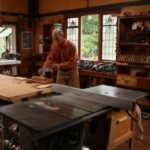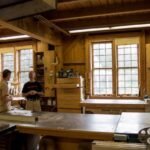The Joys and Jumbles of My Woodworking Journey
So, there I was, sitting at my cluttered workbench with a half-drunk cup of coffee going cold—again—and staring at a pile of hardwood. We’re talking about good stuff here: a nice piece of cherry and some oak that I had left over from a cabinet project last summer. You’d think I’d be brimming with inspiration, right? But nope. All I could think was, “What the heck am I even doing?”
I had this idea, you see. I wanted to create a custom tabletop for my patio that would add a little character to the dull concrete slab. I envisioned this beautiful, multi-toned surface that would catch the sunlight just so, maybe even a bit of envy from the neighbors. But, well, let’s just say things took some interesting turns.
The First Cut is the Deepest
I remember vividly that first cut on the cherry wood. There’s nothing quite like that satisfying "thunk!" as the saw blade bites into the grain. But then you get that noise—the high-pitched whine of the saw that makes you think, “Am I really doing this right?” I had splurged on a decent table saw from a local hardware store, a Grizzly model, and let me tell you, when it works, it works. But if you’re off, even a little, it can ruin the whole piece.
And boy, was I off. I had measured the dimensions all wrong, and there I was, staring at this beautiful slab now reduced to a sad little rectangle. I almost gave up there. I remember leaning back in my chair and thinking, “What on earth am I even trying to accomplish?” But then my buddy Joe from down the street popped into my head. He’s always going on about how you learn the most when things go sideways. So, I decided to keep going. Bad decision? Maybe. But it was a decision I was living with.
Lessons in Humility
As I got deeper into the project—more cuts, some sanding here and there—I realized that this whole woodworking thing is as much about humility as it is skill. I’d made some jigs for my table saw that I thought were all clever. I was feeling pretty pleased until I realized my “perfect” jig was doing a terrible job of keeping the wood straight. Cue: the dreaded splintered edges that are more wood butcher than artisan.
Now, you could say that was my real “a-ha” moment, but it felt more like an “oh no!” moment. I could’ve thrown that slab right into the fire pit and called it a day. But, just like in life, sometimes you gotta work with what you’ve got. I laughed when I finally figured out that I could work those rough edges into something else—a rustic look, if you will. Sometimes, imperfection can be charming, right?
A Smell Like Home
As the project progressed, I started sanding down the oak I had. Oh man, that smell—sweet, nutty, and just rich. It’s as if every scrape from the sandpaper was pulling out the warmer tones, and suddenly, I was back in my grandfather’s workshop. The air in there was always thick with that mix of sawdust and varnish he used. Sanding that oak took a while, but every time I inhaled that aroma, I felt just a smidge less frustrated.
But that came with its own challenges, believe me. I thought I could skip the power-sander and just use a block sander instead. Yeah, not my brightest idea. My arms felt like jelly by the time I was done, and I had more “loves taps” on my fingers than I care to admit. But hey, I got through it, and I even got it smooth enough that when I finally applied the finish, the grain just popped, showcasing that beautiful oak.
Finishing Touches
Now, here’s where I really messed up. I had this bright idea to apply a homemade oil finish to bring out the wood’s character. So, I whipped together a concoction of mineral oil and beeswax that I was sure would give it a nice glow. The smell was incredible—like a honey shop mixed with a lumber yard. But somewhere along the line, I got a little too generous with the oil, and my tabletop ended up sticky.
I almost gave up by that point, feeling like a complete failure. I thought, “What are my neighbors gonna think? They’ll see this sticky mess and laugh!” But I decided instead to embrace it. A bit of extra elbow grease turned the stickiness into a smoother finish.
When I finally stood back and looked at my work—a funky, slightly bumpy tabletop that had seen its share of struggles—I felt a sense of pride. Sure, it wasn’t the perfect surface I had envisioned, but it was mine, every gnarled grain and uneven edge telling a story.
The Takeaway
So, if you’ve ever thought about taking a whack at woodworking—or if you’ve started and found yourself bogged down in mistakes—take it from me: just go for it. Don’t let the fear of imperfection stop you. There’s a unique joy in those bumps and bends. Each one is a memory, a lesson learned, sometimes the hard way but always with a smile. Even if you’ve thrown a project across the garage, just remember—there’s beauty in the struggle.
So grab that wood, make those cuts, and don’t sweat it if it doesn’t look like a magazine spread. Embrace the mess. You might just end up with something beautiful in the end.









